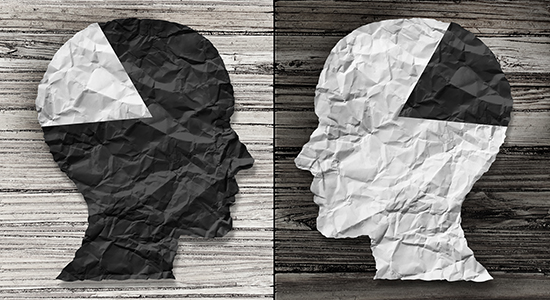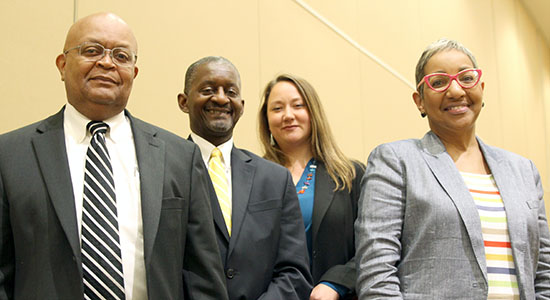
July 20, 2016 – We are all human beings. But as human beings – as products of where we grew up and our genetic and gender makeup – we all have conscious or unconscious biases that affect our thoughts and actions.
“Until we are able to learn and accept those things, it is a challenge to create an inclusive society,” said Janet Green Marbley of Columbus, Ohio, chair of the Diversity and Inclusion Committee for the ABA's Center for Professional Responsibility.
Green Marbley praised the recent work of the State Bar Diversity and Inclusion Oversight Committee and the Diversity Task Force, including its definitions of diversity and inclusion, adopted by the State Bar of Wisconsin’s Board of Governors. The committee serves as the State Bar’s diversity “think tank” to assist, coordinate, and facilitate diversity and inclusion efforts within the organization.
The State Bar’s definition of diversity is very broad, “as it should be,” Green Marbley said. It’s not just about racial differences, but of other things that can be seen or are not able to be seen, such as religion or disability. “The definition of diversity has broadened a great deal from what it was back in the 1970s, when I was first confronted with the issue,” Green Marbley said.
A broadened definition of diversity – and one that can evolve is critical. “That’s very important. Because diversity means opportunities and talent,” Green Marbley said.
And what diversity is changes depending on where you are. In Wisconsin, diversity differs from that in Ohio, where Green Marbley lives. Wisconsin has a greater population of Native Americans, whereas Ohio has a large population of Somalians. “You can’t begin to implement diversity and inclusion unless you know what you’re dealing with and what your demographics look like,” she said.
State Bar of Wisconsin Diversity Statement:
The term “diversity” has a dynamic meaning that evolves as the demographics in the state change. It is an inclusive concept that encompasses, among other things, race, ethnicity, national origin, religion, gender, gender identity, age, sexual orientation and disability. Inclusion helps to create a culture that embraces people from the widest range of talent and experience and promotes understanding and respect for all people and different points of view in the legal profession.
Overcoming Bitter Experience
Many positive steps have been taken – by the ABA, by the State Bar, and other entities – over the past few decades toward greater diversity within the legal profession. But there’s a difference, Green Marbley says, between having a good policy on paper, and making it a reality in people’s lives.
Green Marbley gives an example of her own history as an example, in her experiences in the late 1970s as a law student at Capital University in Columbus, Ohio. She is not ashamed to admit, she says, that she was admitted solely because of Affirmative Action. Capital University had set aside a number of student spots for minorities (in her class, entirely by African-American students). In 1976, there were no computers used to sign up for classes – students physically waited in line to sign up for each class. And at Capital University, there was one line for Affirmative Action students, and an entirely separate line for everyone else.
Shannon Green is communications writer for the State Bar of Wisconsin, Madison. She can be reached by email or by phone at (608) 250-6135.
That physical separation became symbolic for how she and the other minority students were treated throughout her law school years. Her attempts to join student associations were rebuffed, and they formed their own black students’ association.
Was there diversity? Yes. “But in terms of inclusion, it was horrible,” Green Marbley said.
While Affirmative Action opened the door, it was her own hard work that got her out, she said. But she left feeling “very, very bitter” that she and the other minority students were kept on the outside by the other students – something that continued as she began her work as a lawyer.
Green Marbley's experience is not unique and is not something just confined to the 1970s. Starlyn Rose Tourtillot, a member of the Diversity and Inclusion Oversight Committee and an attorney with the Menominee Indian Tribe of Wisconsin, says Native American attorneys frequently experience exclusion, disrespect, and marginalization in the profession - and that the number of Native American law students is dropping. "They are even more marginalized than other minorities."
In 2016, true inclusion remains one of the biggest challenges of any profession or group, yet is of vital necessity to the legal profession, says Milwaukee County Circuit Court Judge Carl Ashley, chair of the State Bar of Wisconsin Diversity and Inclusion Oversight Committee.
As the legal profession becomes increasingly more diverse, it also needs to be more inclusive. Making it happen means confronting implicit – or unconscious – bias, Judge Ashley says.

Pictured here as panelists for the session "Diversity and Inclusion in the 21st Century" at the 2016 State Bar Annual Meeting & Conference on June 16, 2016, are, from left: Lindsey Draper, Judge Carl Ashley, Starlyn Rose Tourtillot, and Janet Green Marbley.
We All Have Implicit Bias
A path to actual inclusion is understanding implicit bias, suggests Green Marbley.
According to the Kirwan Institute for the Study of Race and Ethnicity at Ohio State University, implicit bias is:
-
Attitudes or stereotypes that affect our understanding, actions, and decisions in an unconscious manner
-
Biases, both favorable and unfavorable, activated involuntarily and without intentional control
-
Often concealed for purposes of social and/or political correctness
We all have our own implicit bias, says Judge Ashley. Including himself. And it greatly affects our interactions with others. “Understanding that concept is extraordinarily important.”
Racist, sexist – those are uncomfortable, negative labels. Yet, Green Marbley will admit that she herself, an African-American woman, holds those biases.
“I know I left law school very, very bitter because of my experience. Then I came to work in my profession in the late 1970s and I was treated the same way,” Green Marbley said. “I’m a human being –you can’t have that happen without developing bitterness.”
She knew such bitterness did not help her in her career as a lawyer, or in her family life. “I had to recognize and deal with my own experience.”
Like an attendee at an Alcoholics Anonymous meeting, she had to admit and confront her own implicit biases, before she could move on.
It is something each of us needs to deal with – a task that is very difficult without training, according to Green Marbley.
Implicit Bias: Take the Test
Do you have it? Take the test and see. Researchers at Harvard have put together tests that measure attitudes and beliefs that people may be unwilling or unable to report. The test can be used as a teaching tool to help us recognize the possibility of unintended bias, Green Marbley says.
From Paper to Action
“So how do you make inclusion a reality?” asks Green Marbley. It’s one thing to have such a policy on paper. But how do you implement a program that results in real-world, tangible inclusion?
Diversity efforts have long been a part of the American Bar Association’s efforts, most recently through the ABA Diversity & Inclusion 360 Commission, created in 2015 by ABA President Paulette Brown. The commission’s work includes efforts regarding implicit bias.
ABA Resolution 107 proposes that diversity and inclusion CLE training become mandatory:
“This resolution will increase the legal profession’s understanding and awareness of issues relating to diversity and inclusion, and the elimination of bias, by ensuring that all attorneys who are obligated to comply with MCLE requirements receive education related to diversity and inclusion, and the elimination of bias.”
Such training should be indeed mandatory, Green Marbley says. “Offer training so the profession knows what this means. It’s one thing to read it on paper and say I’m in favor of that, but it’s another thing to try to actually put it into action,” Green Marbley said.
We all have unintended biases. Until we are able to learn and accept those things, it’s challenging to create an inclusive society.
And putting it into action doesn’t mean you have to be friends with everyone. But it is about ensuring that talent and ability are not squelched due to bias. “It’s about making sure that once you start to implement programs so you have a variety of different people, those people don’t feel excluded when they come in,” Green Marbley said.
It’s about answering the question: Once your organization includes a diversity of people, what happens then? “Once you’re in the dance, do you get out on the floor? Do you get a chance to really dance when you’re there?” asks Judge Ashley. “That’s what inclusion is about.”
Fortunately, most researchers agree that implicit bias can be gradually unlearned, Green Marbley said.
“For example, when I’m with a group, my first reaction is to look to see how many other black females are there, then women. That’s an unconscious reaction that I’m learning to untrain myself to do,” she said. “We all have unintended biases. Until we are able to learn and accept those things, it’s challenging to create an inclusive society,” she said.
It can be gradually unlearned, but usually not without training and focus. And now is the time to confront it directly.
“It doesn’t have to be that elephant in the room,” Green Marbley said.
Look for the Webcast Seminar, "Diversity and Inclusion in the 21st Century," in September
Janet Green Marbley, Judge Carl Ashley, Starlyn Rose Tourtillot, and Lindsey Draper spoke in the CLE session, “Diversity and Inclusion in the 21st Century,” at the State Bar of Wisconsin Annual Meeting & Conference on June 16, 2016. Their presentation will be available as a CLE webcast seminar, with other webcasts from the conference, on Sept. 12, 13, 29, and 30. The webcasts will be at no additional tuition for those who attended the conference. Look for more information to come on WisBar's Marketplace.
Becoming a Culture of Inclusivity
Creating inclusivity isn’t just the task of entities like the State Bar’s Diveristy and Inclusion Oversight Committee. It may start there, but it needs to filter through every part of the organization, Green Marbley says.
“Don’t make the mistake of expecting those entities to do all the work,” she says. Each of the 100-plus sections and divisions of the ABA keeps diversity and inclusion in mind when planning events or activities.
One example is making an effort for a programming panel to be diverse, and reaching out to local bar associations. “That’s a simple thing to do,” Green Marbley says. “It has to become the culture of the organization, that it’s everyone’s job.”
And inclusion not just a matter of race and ethnicity, but also of gender, sexual orientation and identity, religion, disability, and national origin.
“It’s important that this conversation continue,” says Lindsey Draper, member of the State Bar Diversity and Inclusion Oversight Committee. “There are so many things happening in our county right now. It is so important that we as lawyers be among the leaders in trying to direct where we go.”
